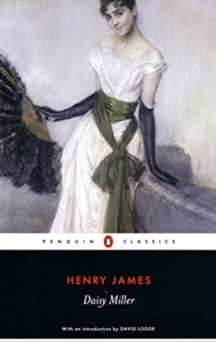
The novella Daisy Miller was published in 1878, the same year James published his novel The Europeans and two years before the publication of Washington Square. Portrait of a Lady came a little later, in 1881. It’s a pure coincidence that those are exactly the books by Henry James that I’ve read so far. Plus, the novella Madame de Mauves, which is from 1874. Madame de Mauves is the only one I’ve read while blogging. You can find the review here.
Henry James was very fond of novellas and as soon as you look at his extensive bibliography, you can see just how fond of them he was. Maybe I’m wrong, but I got the impression that Daisy Miller might be his most famous novella. That’s not surprising as it’s James at his most readable. People often complain that he’s not accessible, that his sentences are difficult. None of this is the case here. The writing is fluid and elegant, never clunky, never overcomplicated. And the story is engaging too.
Winterbourne is a young American who lives in Geneva most of the time. At the beginning of the story, he’s visiting his aunt in Vevey. While out on a walk, he meets a peculiar boy who is followed by his older sister. Winterbourne can’t take his eyes off the young woman. She’s so beautiful and elegant. But very different from the other young American women he met in Switzerland. She walks around without her mother or another chaperone, openly flirts with Winterbourne, teases him and is very capricious. Flirting is something young American girls, unlike the Europeans, do a lot. But not exactly with as much liberty as Daisy.
Certainly she was very charming, but how deucedly sociable! Was she simply a pretty girl from New York State? Were they all like that, the pretty girls who had a good deal of gentlemen’s society? Or was she also a designing, an audacious, an unscrupulous young person? Winterbourne had lost his instinct in this matter, and his reason could not help him. Miss Daisy Miller looked extremely innocent. Some people had told him that, after all, American girls were exceedingly innocent; and others had told him that, after all, they were not. He was inclined to think Miss Daisy Miller was a flirt—a pretty American flirt. He had never, as yet, had any relations with young ladies of this category
His aunt tells Winterbourne right away, that she’s beneath him, even though it’s obvious she’s extremely rich.
But don’t they all do these things–the young girls in America?” Winterbourne inquired.
Mrs. Costello stared a moment. “I should like to see my granddaughters do them!” she declared grimly. This seemed to throw some light upon the matter, for Winterbourne remembered to have heard that his pretty cousins in New York were “tremendous flirts
After a trip to Château de Chillon, Winterbourne returns to Geneva and Daisy and her mother and brother travel to Rome.
The following winter, Winterbourne meets Daisy again in Rome. She’s the talk of the town. People gossip because she’s always seen alone with men, most of the time with one very good looking Italian.
The news that Daisy Miller was surrounded by half a dozen wonderful mustaches checked Winterbourne’s impulse to go straightway to see her. He had, perhaps, not definitely flattered himself that he had made an ineffaceable impression upon her heart, but he was annoyed at hearing of a state of affairs so little in harmony with an image that had lately flitted in and out of his own meditations; the image of a very pretty girl looking out of an old Roman window and asking herself urgently when Mr. Winterbourne would arrive.
While Winterbourne found many excuses for her when he first met her, surprising her, in the middle of the night, in the Colosseum alone with the Italian, disgusts him.
Since Daisy Miller is a novella, writing more would give away the ending. Let’s just say – it’s tragic.
Daisy Miller is such a strong creation. She’s free, she’s witty, she doesn’t care about what people say. But Winterbourne and the reader wonder why. Is it because she is so innocent or is it because she’s without morals? The ending reveals which of the impressions is right.
James is always interested in the different attitudes of Europeans and Americans and how these change through travel and living abroad. It seems that Daisy Miller puzzles them all. She’s entirely her own person. The little brother is very unusual too and so is the mother who doesn’t seem to be able to guide her two children. I would have loved to be introduced to the dad, but we never get to see him as he stayed in the US.
The society James describes in this novella, is very cruel. They have their rules and if you don’t play by them you get shunned or ostracized. No matter how rich you are.
Because the book is called Daisy Miller, one could assume its eponymous heroine is the main character, which in a way she is. But Winterbourne is just as important because we see the story filtered through his eyes. This filtering, and the way he interprets everything, tells us a lot about him and the society he lives in.
As I said, Daisy Miller is highly readable and very accessible. Even though the end is tragic, it’s neither sombre nor depressing as so many of James’ other books.
